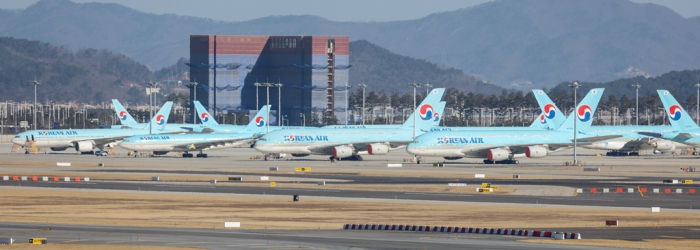Airlines
Korean Air’s stock lags US peers' on slow demand recovery
For international flight demand recovery, it needs to consult with about 170 countries restricting Koreans' entry, says one analyst
By Apr 14, 2022 (Gmt+09:00)
2
Min read
Most Read
LG Chem to sell water filter business to Glenwood PE for $692 million


Kyobo Life poised to buy Japan’s SBI Group-owned savings bank


KT&G eyes overseas M&A after rejecting activist fund's offer


StockX in merger talks with Naver’s online reseller Kream


Mirae Asset to be named Korea Post’s core real estate fund operator



Korean Air Lines Co.’s stock is underperforming those of its US rivals on concerns that South Korea’s top carrier is unlikely to immediately benefit from the economic reopening. The flagship airline will also be bruised by the weaker won currency and surging fuel costs.
US airlines’ shares jumped on Wednesday after Delta Air Line Inc.’s quarterly earnings beat market expectations with its January-March sales at $9.4 billion, higher than the $8.9 billion forecast. The US' third-largest airline also expects to turn to the black in the current quarter on robust consumer demand.
Delta’s stock jumped 6.21%, extending its gains to 36.23% versus its lows last month. American Airlines Inc. and Southwest Airlines Co. also soared 10.62% and 7.54%, respectively, on the day.
On the other hand, Korean Air rose 0.8% to end at 31,550 won ($25.7) in South Korea’s main stock market on Thursday, up some 16% from its lows in March.
NEED TO CONSULT WITH 170 COUNTRIES
The disparity comes as US airlines generate much of their sales from domestic flights, while Korean Air heavily relies on international flights.
As of 2019, sales of US airlines’ domestic flights accounted for about 60% of their total revenues on average. Therefore they can increase sales as long as the authorities don't impose regulations on movement within the country.
But Korean Air’s domestic flights made up only 4% of its total sales in the same period.
“In order for international passenger flights to recover to pre-COVID-19 levels, it (Korean Air) needs to consult with about 170 countries that are restricting entries of Koreans,” said Kim Young-ho, an analyst at Samsung Securities Co. “It could take longer than expected to see a recovery in international passenger flight demand.”
South Korean airlines’ stocks have been supported since last year on hopes for recovery with countries worldwide opening their borders.
The combined market capitalization of South Korea’s five carriers excluding Asiana Airlines that decided on capital reductions in 2020 more than tripled to 13.3 trillion won from 4.4 trillion won in 2019.
“It is hard to explain the increase only with hopes for improvement in their earnings based on the potential international passenger flight recovery,” Kim said.
CURRENCY, FUEL
Surging fuel prices and the softer won are also expected to hurt Korean Air's earnings, analysts said. Meritz Securities predicted Korean Air’s earnings before interest, taxes, depreciation, and amortization (EBITDA) on a separate basis to fall 36.2% this year while forecasting that its operating profit may tumble 75%.
Investors, however, continued to hope for an eventual recovery in international passenger flights.
“The recovery of international passenger flight demand for Korean Air will be slower than that for US carriers, but the trend of rising demand is not different,” said Jung Yeon-seung, an analyst at NH Investment & Securities. “So, (Korean Air’s) share price will follow the demand.”
Write to Sung-Mi Shim at mshim@hankyung.com
Jongwoo Cheon edited this article.
More to Read
-
 AirlinesGlobal airlines raise flights to pre-COVID levels on border reopening
AirlinesGlobal airlines raise flights to pre-COVID levels on border reopeningMar 14, 2022 (Gmt+09:00)
4 Min read -
 Korean stock marketKorea reopening stocks rally as govt. eases COVID-19 restrictions
Korean stock marketKorea reopening stocks rally as govt. eases COVID-19 restrictionsMar 11, 2022 (Gmt+09:00)
3 Min read
Comment 0
LOG IN


